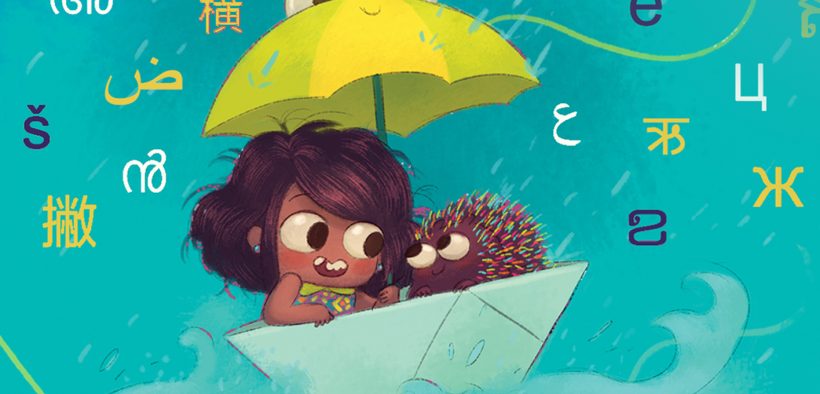The nuances of translating children’s storybooks into mother tongue languages

By the Pratham Books Language Team
For every book, the translator is the one person who reads it more closely than any other reader, sometimes even closer than the writer. In picture books, the translator does not merely translate the text to a different language; they also make sure the text is in harmony with the illustrations. Here, a translator is entrusted by the writer and illustrator to capture the essence of the story, and also by the reader who probably won’t read the book in its original language.
Within the language team at Pratham Books, we often think about how we can constantly improve the translation process, and recently spoke to some experts on the process of translation, particularly for children’s storybooks. We arranged discussions with two translators, both of whom are exceptional in their own ways. Rather than a mirror, the talks ended up being a kaleidoscope and showed the translation process to us in multiple colourful ways.
Re-energized, we are going back to translating more picture books, making them more lovely in our languages. We also want to share these talks with the larger translation community, in the hope that you find joy in, and assurance about your work, and also see it in a new light.
The first talk was with Jerry Pinto, an award-winning writer, poet and translator.
Here are our major takeaways from Jerry’s talk:
• Reading aloud is the ‘riyaz’ for translating for children. Your riyaz should be to read aloud a book every day. Reading aloud is very important when you’ve translated something. Reading the piece makes us realize our minor errors and the tone, expressions, the inherent music and one can revise the draft to a fair level of perfection easily.
• Translation is a balancing act between two extremes. An attempt to make the text completely at home in the target language will be defeated by the artificiality of the construct; it will become colourless, odourless and tasteless. An attempt to retain all the source language’s specificity and cultural nuances will also be a failure because it will be unreadable and clumsy. So what you are trying to do is to walk the middle path, where some of what drew you to the text in the first place is saved but you are also aware that the reader brings some expectations to the table.
• When you make a change in the original text while translating it, you must have a logical reason behind the change. When you have thought about it clearly, have arrived upon your choice through an active, logical and objective thought process, then that is the best thing you could have done.
• A writer will not insist on the translators to use pani puri in all the languages, just because they used it unless it forms a part of the story. Let’s say a grandma and a child go out and eat pani puri. If the grandma uses pani puri to tell something inherently linked with pani puri to the child, we have to retain it. If it remains merely a thing they eat one day, there is no harm in replacing it with a more common, more identifiable food item relevant to readers of that language.
• The author places complete trust in the translator and believes that the translator will do the best with their writing. When you are trying to do your best for that person, you cannot, (and should not) compromise with the language at all. Keeping that trust intact is key as a translator. This is why the act of translation makes us learn and understand more about our mother tongue.
• The golden rule about translating a rhyme is not rhyming words themselves but its music. In order to work on the rhyme, one tends to twist the words. As a result, the music and inherent logic of the words are probably damaged. While translating a poem, try to find the inherent music of the poem by first reading it again and again. Then try to translate that kind of music in your (target) language that works best for that particular piece of poetry.
• The laws of aerodynamics decree that the bumblebee should not be able to fly! Similarly, by the laws of language, no one should be able to translate. So the first thing to do is to forget that you have to make every choice the right choice. You have to get down to it and do it. Then you have to make sure you got it as right as you can.
Listen to Jerry’s talk here:
The second talk was with Arunava Sinha, a seasoned translator who has translated many major Bengali works into English. He also teaches courses on creative writing and translation at Ashoka University.
Here are some key takeaways from Arunava’s talk:
• In stories that are set in a different cultural context than that of the translation language, one should resist the urge to localize the kinship terms or to find an equivalent idiom. It can sound a little strange to the reader but it will remind the reader that the story is set in a different cultural context.
• The most intimate form of reading is translation. No one reads closer than a translator, not even the author. Translation is an act of adding a little diversity to the text, and we should not wish it away by saying that there is only one definitive version of the text in every language.
• Translating for children is more difficult, because the best writers for children write in a remarkably playful, light and fun way, and sometimes in whimsical tones. It is hard to capture these nuances. If you don’t pay attention to this detail, it flies past you. It always helps if you are in a happy and relaxed frame of mind.
• It is perfectly fine to retain the terms or phrases while translating if they do not exist in the target language. Or coin a powerful word. For example, Satyajit Ray in his Feluda series used the term ‘satellite’ for the ‘sidekick’. It was received so well by Bengali readers that the term is now used by many other writers in Bengali. So he coined a new term for the language.
• An editor is the translator’s best friend. Editors aren’t credited, yet they are the ones who spend the most time with the book and do their best to make it accurate and beautiful. Editors assure the consistency of voice in the book, and they think of the questions that will arise in a future reader’s mind while reading that book.
• When translating for young readers, try reading the book to a child. But if that isn’t possible, delving into one’s own memories of being a child helps. Also, try not to read too much into a text so that our familiarity grows too much with it, and then we skip or make our own meanings. It is best to be led by the original words.
• If the original work itself is in some way written for children, then translating it with a reasonable degree of faith will ensure that the translation is also equally child friendly. The translator should be sensitive and translate intelligently, but they don’t have to put in any extra effort in order to make the text suitable for children because the original writer has actually done that work already.
• Children dive into a text in the same way an adult does, and they find and navigate their way through it. When they don’t understand something, they ask questions. They are keen on understanding things, on building the worlds that they see in the text in their minds. So there is no point in shielding children from anything, in terms of simplifying or toning down things for them.
• “Translating orally helps. For example, when I am translating from English to Bangla, I tend to do it more orally. I have tried dictating the oral translation to my computer, and have discovered that it works better. Because I think while talking we unlock a different part of our brain and unlock a different vocabulary from the one that we use while writing.”
Watch the entire discussion with Arunava here:
